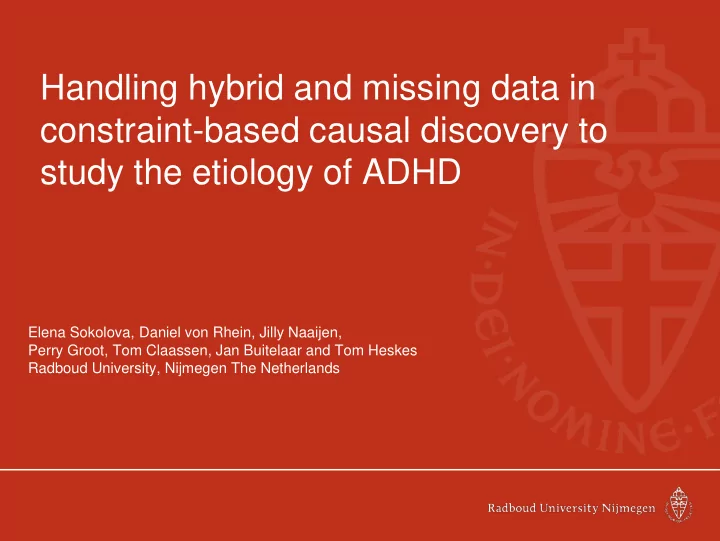

Handling hybrid and missing data in constraint-based causal discovery to study the etiology of ADHD Elena Sokolova, Daniel von Rhein, Jilly Naaijen, Perry Groot, Tom Claassen, Jan Buitelaar and Tom Heskes Radboud University, Nijmegen The Netherlands
Does wine drinking prevent heart disease? Wine drinking and lower rate of heart disease are associated Wine Less heart drinking diseases
Does wine drinking prevent heart disease? All possible models Wine Less heart Wine Less heart drinking diseases drinking diseases Common cause Wine Less heart drinking diseases
Does wine drinking prevent heart disease? All possible models Wine Less heart Wine Less heart drinking diseases drinking diseases High income Wine Less heart drinking diseases
A way to learn causality 1. Take randomly 200 people 2. Randomly split them in controls and treatment groups 3. Force treatment group to drink wine, forbid control group to drink wine 4. Wait 40 years 5. Measure correlation [Randomized Controlled Trial]
Can we learn causal relationships from observed data? Yes!
Conditional Independence X and Y are conditionally independent given Z : Given Z • knowledge of X provides no information for Y • knowledge of Y provides no information for X X Z Y
Conditional Independence X and Y are conditionally independent given Z : Given Z • knowledge of X provides no information for Y • knowledge of Y provides no information for X X Z Y
Conditional Independence X and Y are conditionally independent given Z : Given Z • knowledge of X provides no information for Y • knowledge of Y provides no information for X X Z Y
Learning causal network Bayesian constraint-based causal discovery: - Uses Bayesian approach to estimate the reliability of the causal statements, avoiding propagation of unreliable decisions T. Claassen, T. Heskes. A Bayesian approach to constraint based causal inference . In UAI 2012
BCCD Basic idea: • Step 0 Start with a fully connected graph. • Step 1 Estimate the reliability of a causal statement ( 𝑌 → 𝑍 ) using Bayesian score. • Step 2 If a causal statement declares a variable conditionally independent, delete an edge. • Step 3 Rank all causal statements and orient edges in the graph.
BCCD The reliability of the causal statement 𝑀 given the data D using Bayesian score : 𝑞(𝐸|ℳ)𝑞(ℳ) ℳ∈𝑁(𝑀) 𝑞 𝑀 𝐸 = 𝑞(𝐸|ℳ)𝑞(ℳ) ℳ∈𝑁 There is a closed form solution for 𝑞( 𝐸|ℳ ) : • Discrete random variables - BD metric • Continuous Gaussian variables - BGe metric
BCCD Advantages of the method: • Robust • Can handle latent variables • Gives an indication whether an edge does exist or not Limitation of the method: • Works only with discrete variables or Gaussian variables • Cannot handle missing values
Undirected graphs • Precision matrix- inverse of correlation matrix • Precision matrix - the set of conditional independencies • Add sparsity constraints
Undirected graphs Glasso to find optimum Θ 𝜇 = argmax Θ {logdet Θ − tr Θ𝑇 − 𝜇 Θ 1 } Goodness of fit Sparsity penalty - Θ = Σ −1 inverse of correlation matrix - 𝑇 - empirical correlation matrix • Spearman instead of Pearson partial correlation • Adjust Spearman correlation, to make it closer to Pearson • Shift correlation matrix to the closest one if it is negative definite • Use EM if there are missing values
Assumptions • Data is a mixture of discrete and continuous variables • Data is missing completely at random (MCR) • Relationships between variables are monotonic, i.e. variables follow a so-called non paranormal distribution
Method extension • BIC score: 𝑜 − log 𝑁 𝐶𝐽𝐷 𝑡𝑑𝑝𝑠𝑓 𝑬 = 𝑁 𝐽(𝑌 𝑗 , 𝑄𝑏 𝑌 𝑗 ) Dim 2 𝑗=1 Goodness of fit Complexity penalty • Mutual information 𝐽 𝑦 1 , … , 𝑦 𝑜 = − 1 2 log |𝑆| |𝑆 𝑄𝑏 𝑗 | • Use Spearman instead of Pearson • Use EM if there are missing values
Simulated data • Waste Incinerator Network, 𝑦 3 transformed • Sample size: 100, 250, 500, 1000 • Estimated PAG accuracy, precision, and recall
0% missing
5%, 30% missing BCCD
5%, 30% missing PC
Conclusions • EM performs better than other methods when there is a significant amount of missing values • Spearman adjusted leads to unstable matrix and many spurious edges
Real world Data set, ADHD MID task Type of data: • Genetic information (NOS1, DAT1) • Brain activation (OFC, VS, anticipation and feedback) • Behavioral (symptoms, aggression, reaction time, IQ) • General (age, gender)
Assumptions • Assumed that missing values are missing at random • Combined two types of symptoms assessments: by parents and by psychiatrist. • Incorporated prior knowledge that nothing can cause: • Gender • Feedback VS is not caused by HI
Real world data ADHD MID task A B : A causes B A B : latent common cause A B : selection bias : cannot distinguish between arrow and tail
Real world Data set, ADHD reversal task Type of data: • Experiment related (lose shift, win stay, error) • Behavioral (symptoms, IQ) • General (age, gender)
Assumptions • Assumed that missing values are missing at random • Incorporated prior knowledge that nothing can cause: • Gender
Real world data ADHD reversal task A B : A causes B A B : latent common cause A B : selection bias : cannot distinguish between arrow and tail
Conclusions and Future work • Extension of the BCCD algorithm for mixtures of discrete and continuous variables • Works well under the assumption of non paranormal data and values MAR • Further developments: - More complex relationships - Longitudinal data
Thank you for your attention!
Recommend
More recommend